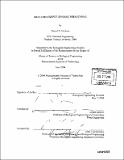High-throughput genomic phenotyping
Author(s)
Ericksen, Daniel S. (Daniel Southwick), 1977-
DownloadFull printable version (3.056Mb)
Other Contributors
Massachusetts Institute of Technology. Biological Engineering Division.
Advisor
Leona Samson.
Terms of use
Metadata
Show full item recordAbstract
In the wake of the development of technology to sequence the complete genome of an organism, it has become expedient to generate methodologies to elucidate and characterize the function of all genes constituting the complete genetic makeup of an organism, whereby the knowledge of the genetic code may be for scientific and intellectual profit. This work consists of an investigation into two possible methods for determining the role of genes involved in the DNA and cellular damage response, though the methods are generally applicable to investigating a wide variety of biological pathways and responses. A library of approximately 4,800 yeast (Saccharomyces cerevisiae) deletion strains produced by the Saccharomyces Genome Deletion Project and consisting essentially of all possible mutants having one non-essential gene deleted (and replaced with unique identification tags called "bar codes") from the genome are employed in this endeavor. The methods focus on gathering phenotype data in a high-throughput manner and in response to the alkylating agent methyl methanesulfonate (MMS). The first method makes use of a new technology called the Living ChipTM, which can hold libraries of compounds or cell cultures in an array of 50-nl channels and which could ideally accommodate all deletion strains on a single array. The second method involves pooling all strains together in a single culture and allowing them to grow competitively to determine their relative fitness based on a specific treatment.
Description
Thesis (S.M.)--Massachusetts Institute of Technology, Biological Engineering Division, 2004. Includes bibliographical references (p. 63-65).
Date issued
2004Department
Massachusetts Institute of Technology. Department of Biological EngineeringPublisher
Massachusetts Institute of Technology
Keywords
Biological Engineering Division.